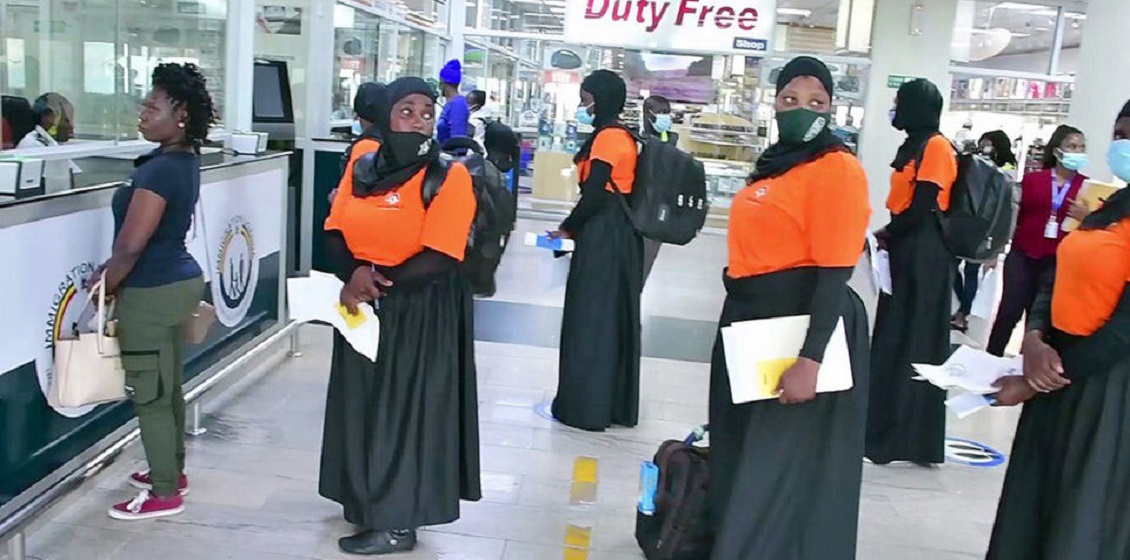Ugandan women continue to flock to the Middle East mainly to work as maids, despite harrowing tales of enslavement, torture and discrimination. In fact, many go back for a second and third stint, even after they have spoken very badly about the way they were treated while they worked in homes there.
Researchers Dr. Julaina Obika of Gulu University and Prof. Hanne Overgaard Mogensen of the University of Copenhagen are interested in finding out why these women are choosing that path despite such working conditions. Their study seeks to establish the impact of labor migrations from Uganda to the Middle East on gender relations and livelihoods in Uganda. So far, their findings show that while there are plenty of negative stories, the livelihood influence of Middle East labor on some families in Uganda is significant, and women are increasingly taking on the role of head of the family in a society that is traditionally patriarchal.
A typical experience
Fatuma [not her real name], 29, describes her first attempt to work in the Middle East as “a nightmare”. Her ‘escape’ in 2018 from a house in Dubai, after serving 10 months on her two-year contract, was movie-like:
“One day she [the boss] forgot the keys in the kitchen lock. It was in the morning and most of the family members were still asleep. I pulled out the keys, ran to the basement where my room was, picked up my bag which was always packed, returned to the kitchen and grabbed a knife. I went to the living room where she was and I told her ‘if you want peace let me go peacefully. Take me back to the office [labor agency] or else I will be forced to use this knife on you’.”
After making her point, and with the keys in her hands, Fatuma ran out of the house, leaving her employer in shock.
“I think because of the fear of what I could do next, they called the office and they quickly took me there. The office already knew about our issues because I had complained many times but they were not helping me,” she tells me.
Fatuma, known to her relatives and friends as a very humble and friendly person, had left behind her partner and a baby of fourteen months to join the ever-increasing number of young Ugandan women going to the Middle East to do domestic work.
Immediately when she entered the house to start her new job her phone was taken away from her, so she could have very limited communication with her people, through her employers’ phone.
“That made me feel so lonely in that house to the extent that I developed suicidal thoughts. She [the boss] had eight grandchildren whom I was forced to take care of, but I was not allowed quality time [phone calls] with my own child. It was tormenting!” Fatuma says.
Her plight over those months included verbal abuses related to her race, being given little food, working for abnormal hours and, although her contract indicated that she was to work in one house, she would be forced by her employer to work in three other houses where her employers’ daughters were married.
Fatuma’s employer had not paid her for three months by the time of the knife incident. The agency told her to use that money to buy Fatuma a flight ticket.
“I returned home. I had planned my escape months earlier. It reached a point where I had become rebellious. If they told me to do something that was not in my contract I wouldn’t do it. So, they started to lock me in the house and my boss would keep the keys on herself,” she says.
In 2021, however, Fatuma returned to Dubai, again as a laborer. This time she was working for a cleaning company. Again, she left behind her partner and their baby of only eight months.
Researchers’ questions
“How come they are choosing this [work in the Middle East] as an alternative or a pathway for livelihood? Why is domestic work in the Middle East becoming a very attractive choice for a lot of women?”, asks Dr. Obika. Those are some of the questions in the researchers’ probe. It is important to note that the young women I interviewed for this article are not among the researchers’ respondents.
Between 2016 and mid-2022, over 220,000 Ugandans left for work in the Middle East. 85 percent were domestic workers, with women taking up the larger share of 75%. Those figures do not include workers who left the country illegally.
The labor export sector has become an important revenue source for Uganda with the country’s tax body receiving 30 US Dollars per worker requested by a foreign agency while local labor companies pay 2m Ugandan shillings (approx. 535 US Dollars) each for a license. By May 2022, Uganda had licensed more than 230 labor export companies and over 400 foreign recruitment agencies.
Annual remittances from Ugandans working abroad amount to 1.3bn US Dollars – more than half of that (700m US Dollars) comes from those working in the Middle East. The sector is estimated to annually generate for the country tax revenue of 4.5t Ugandan shillings (approx. 1.2bn US Dollars).
Context of the study
Dr. Obika and Prof. Mogensen began their research in 2018 and it should have ended in 2022, but due to Covid-19 disruptions, they received an extension to 2024. Their study is part of a wider DANIDA-funded project, Imagining Gender Futures in Uganda (IMAGENU), which is looking at marriage, partnerships and changing gender relations in Uganda. Different studies are going on under four subthemes: Livelihoods, Education, Child filiation and Health (reproductive and mental).
“Hanne and I are looking at the work package on livelihoods and we zeroed down on this growing trend of women, especially young women, going to the Middle East in search of jobs,” Obika says. “We are following the two components about this decline in marriage and then our sub study about migration.”
Between them, the researchers have interviewed over 50 men and women who have made the journey to the Middle East and they have closely been following the stories of 11 of them for more than three years.
“It is important to say that we look for themes recurring in these people’s lives, but not for statistical significance. We primarily look at how they manage to continue life once back in Uganda – what has this experience in the Middle East done for their livelihood options also after they return”, says Mogensen.
Geographically, they are focusing on northern Uganda, specifically the districts of Gulu and Pader, but they also bring in comparison with Eastern Uganda – Tororo and Jinja districts – as well as Kampala, which is the hub for the women in transition to the Middle East. They began their study focusing on women, but later included men for accuracy.
Obika says: “When you talk to a Ugandan about work in the Middle East it is like a synonym for slavery, torture, discrimination, racism, you name it. We talk to people all the time and they tell us exactly these kinds of fears that they have. What we have found is that despite negative press and the stories that are so much on social media, some of the young women we have spoken to have gone, come back and then are trying to go back again. And our question is why?”
The answers could be diverse. But livelihood is, certainly, at the center of this journey from Uganda to the Middle East.
William Odinga Balikuddembe is a science journalist based in Kampala, Uganda








